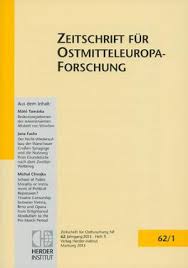Die Konzeption der litauischen Nationalliteratur (von den 1890er bis zu den 1930er Jahren)
The Concept of a Lithuanian National Literature (from the End of the 19th Century until the First Half of the 20th Century)
Author(s): Viktorija ŠeinaSubject(s): Education, Lithuanian Literature, Nationalism Studies, 19th Century, Pre-WW I & WW I (1900 -1919), Interwar Period (1920 - 1939), Theory of Literature
Published by: Verlag Herder-Institut
Keywords: national literature; nationalism; Lithuanian literature; multilingual literature; literary historiography; school curriculum;
Summary/Abstract: This article investigates how the notion and perception of Lithuanian literature took shape at the time of the Lithuanian national movement (from the end of the 19th century until the beginning of the 20th century) and continued to develop during the restoration and naturalization of Lithuanian statehood (1918-1940). The sources I have used for the analysis are taken from both literature historiography and school curricula dating from the period. The investigation reveals how, within the historiography of Lithuanian literature, two opposing concepts of national literature crystalized around the turn of the 20th century: one based on an ethnolinguistic (centering on the Lithuanian language) and the other on a civic notion that centered around the history of Lithuanian statehood. The latter concept of national literature created the opportunity to expand the corpus of literature written in Lithuanian to include texts that had been written during the time of the Grand Duchy of Lithuania in Ruthenian, Latin and Polish. The two differing concepts of a national literature coexisted in historiography and at universities until 1940. However, this situation was not tenable in the area of school education. After the Lithuanian state had been re-established, work began to set up a network of Lithuanian schools. The education ministry was tasked with designing a standardized school syllabus for Lithuanian literature with the aim of unifying the two approaches, namely, the ethnolinguistic concept and the notion of a national literature that integrated the country’s multilingual heritage. In the school syllabuses of 1920, 1923 and 1929, the multilingual concept had a growing influence. From the mid-1920s, however, as a nationalistic ideology took root and continued to strengthen within the political life of Lithuania, the education system was reformed in order to emphasize the nurturing of a national sentiment as the primary goal of education. The model of a multi-lingual national literature no longer fitted in with the national approach in schools—particularly unacceptable was the idea of a shared literary heritage with Poland. Consequently, after the education reform of 1936, the works by Lithuania’s 19th century Polish-speaking poets were dropped from the national canon of educational texts.
Journal: Zeitschrift für Ostmitteleuropa-Forschung
- Issue Year: 67/2018
- Issue No: 2
- Page Range: 196-224
- Page Count: 29
- Language: German

